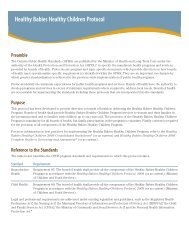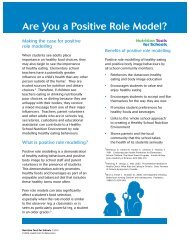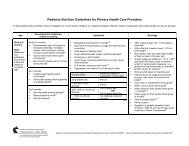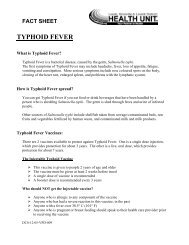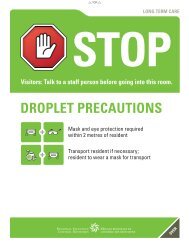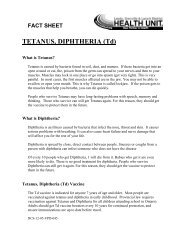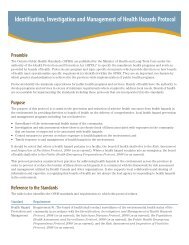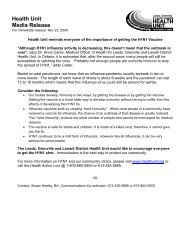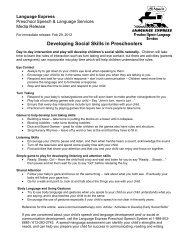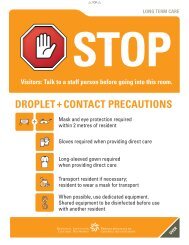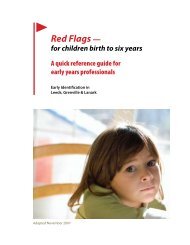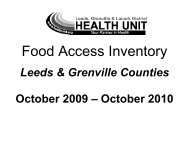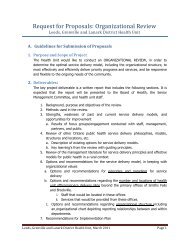Moving Upstream - Leeds, Grenville and Lanark District Health Unit
Moving Upstream - Leeds, Grenville and Lanark District Health Unit
Moving Upstream - Leeds, Grenville and Lanark District Health Unit
Create successful ePaper yourself
Turn your PDF publications into a flip-book with our unique Google optimized e-Paper software.
1. <strong>Health</strong>y Growth<br />
& Development<br />
<strong>Health</strong> Goals<br />
What is it?<br />
Being born healthy, growing <strong>and</strong> developing to a child’s optimal potential are<br />
the basic ingredients of lifelong health. <strong>Health</strong>y growth <strong>and</strong> development<br />
includes the physical, cognitive, social, emotional <strong>and</strong> communication/general<br />
knowledge domains. With healthy development, children can optimize learning,<br />
make friends <strong>and</strong> form healthy relationships, be creative, <strong>and</strong> problem-solve – all<br />
essential skills to be happy <strong>and</strong> have good quality of life. The first six years are<br />
critical for brain development that not only is important for learning, but will also<br />
influence the rest of the child’s life.<br />
What influences it?<br />
Research supports that the following factors influence whether a child will have<br />
healthy development:<br />
<br />
During the prenatal period - absence of genetic problems, avoiding<br />
any infectious diseases (rubella, syphilis, etc.), getting good health care<br />
early, healthy eating, regular physical activity, having support for good<br />
mental health, <strong>and</strong> avoiding stress, tobacco <strong>and</strong> substance use during<br />
pregnancy, along with early recognition of preterm labour.<br />
<br />
During early childhood - breastfeeding, healthy eating, avoiding<br />
infectious diseases, regular health care/developmental assessment,<br />
good maternal mental health, effective parenting, physical activity,<br />
participation in early child development programs (playgroups, licensed<br />
childcare, etc.), avoiding environmental tobacco smoke <strong>and</strong> other toxins<br />
(mercury, lead, etc.), having a safe environment that reduces the risk of<br />
injury (safe sleep environment, use of car seats, homes free from abuse,<br />
violence or neglect, etc.) <strong>and</strong> oral health care.<br />
<br />
For children ages 5 to12- regular play <strong>and</strong> physical activity, healthy eating,<br />
oral health care, developmental assets, self-esteem, adequate social<br />
support (friends <strong>and</strong> family), effective parenting, healthy risk taking,<br />
success at school, avoiding exposure to violence <strong>and</strong> infectious disease.<br />
<br />
During the teen years - good nutrition, healthy sexuality, adequate social<br />
support (peers <strong>and</strong> families), effective parenting, access to employment/<br />
avoiding poverty, education, access to supportive services including<br />
health care, access to knowledge/information, life skills, avoiding<br />
substance use <strong>and</strong> injury, <strong>and</strong> avoiding exposure to violence <strong>and</strong><br />
infectious disease.<br />
<br />
For all ages - Nurturing environment, adequate family income, parental<br />
education, social support, parental health practices, culture, healthy air,<br />
water <strong>and</strong> food.<br />
20<br />
<strong>Moving</strong> <strong>Upstream</strong>: 2013-2018 Strategic Plan<br />
<strong>Leeds</strong>, <strong>Grenville</strong> & <strong>Lanark</strong> <strong>District</strong> <strong>Health</strong> <strong>Unit</strong>



